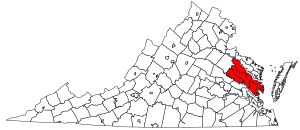Middle Peninsula facts for kids

The Middle Peninsula is the second of three large peninsulas on the western shore of Chesapeake Bay in Virginia, in the United States. It lies between the Northern Neck and the Virginia Peninsula. This peninsula is bounded by the Rappahannock River on the north and the York River on the south, with the Chesapeake Bay to the east. It encompasses six Virginia counties: Essex, Gloucester, King and Queen, King William, Mathews, and Middlesex. Developed for tobacco plantations in the colonial era, in the 21st century the Middle Peninsula is known for its quiet rural life, vegetable truck-farming, and fishing industry.
There are no cities on the Middle Peninsula and little industry. Among the towns found there, West Point has a pulp-and-paper mill. The unincorporated community of Deltaville is a popular spot for city-dwellers seeking a weekend boating on the bay. Tappahannock is a thriving community on the Rappahannock River, and Urbanna has a small but prosperous tourism industry.
Two small land reservations are home to the state-recognized Pamunkey and Mattaponi Indian tribes.
The primary highways on the peninsula are U.S. Route 17 (Tidewater Trail), which connects Fredericksburg with the Hampton Roads area, and U.S. Route 360 (Northumberland Highway), which connects the Northern Neck with Richmond and Danville. Before modern highways existed, passenger ferries and steam freighters linked the entire Chesapeake Bay region.
The two southernmost counties on the Middle Peninsula, Gloucester and Mathews, are now considered to be part of the Hampton Roads metropolitan area. Gloucester County is connected to the Virginia Peninsula by the George P. Coleman Memorial Bridge, which spans the York River. King William County and King and Queen County to the west are part of the Richmond Metropolitan Statistical Area (MSA).
See also
 In Spanish: Península Middle para niños
In Spanish: Península Middle para niños

